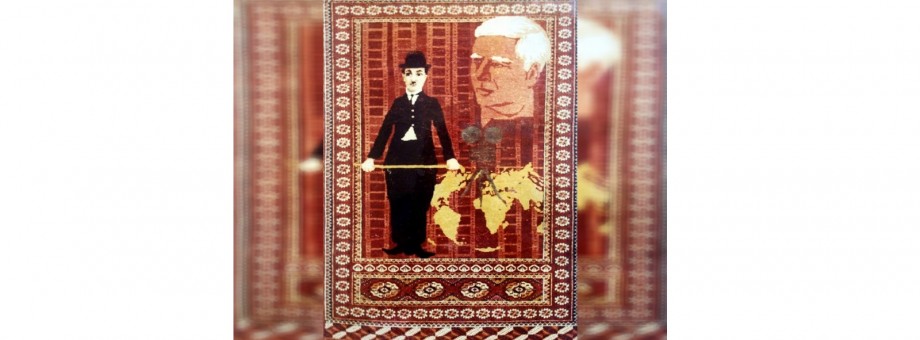“I WILL LEAVE YOU A SMILE...”

(Charlie Chaplin died on December 25, 43 years ago)
“The only thing I am happy with is that I could make people laugh…” said the universal master of the silent movie era and of cinema, the creator of one of the most famous characters in the cinema world - Charlie the Tramp that appeared in short comedies. Charlie Chaplin was a comic genius and a prominent and iconic figure of the 20th century. Millions of people and generations of film audiences laughed and cried together with Charlie Chaplin! This extraordinary person and wonderful actor is widely regarded as a genius, because, he, who may not have realized himself, pushed the boundaries of the ordinary, transcended the limits of time, and crossed the invisible line, where funny things become tragic, trivial matters turn into burning social issues.
His movies showed serious conflicts of human existence in a society of “equal opportunities” to three generations of audiences and not only made them laugh and cry, but, most importantly, think… This is what people are grateful for to the “funny”, eccentric and incredibly resilient Charlie.
…Monsieur Charlie – one of the world’s most famous actors – Sir Charles Spencer Chaplin lived happily in the small town of Corsier-sur-Vevey on the northern shore of Lake Geneva. This “mischievous” fellow from London, who made the entire world laugh, received an avalanche of letters. Once, an unusual parcel arrived from far away.
…New ideas for a new portrait often emerged after an encounter with good books, which were read aloud for the whole family. This was how our family, the avid movie enthusiasts, became familiar with Charlie Chaplin’s autobiography. We discussed it extensively in the evenings staying up late. We decided unanimously to pay loving tribute to Chaplin as a token of gratitude for the great past. The idea for a carpet came to us. We had drawn many sketches before the best one was chosen.
After the household chores were done, my mother and I sat at the loom to weave the carpet centimeter by centimeter. We spent every spare moment and days off making the carpet on the makeshift loom. It was going to be a present for the world-renowned actor, who never forgot to smile.
I cannot help but remember a touching moment. We were tying knots making the carpet, and my father was reading aloud the thick book “My Autobiography” by Charlie Chaplin, as he usually did in the evening. When he was reading about the actor’s engagement with poverty, about his encounter with a Gypsy fortune teller, who told him for a dollar that he would be the wealthiest man in the world, my father fell silent and could not continue reading because he was very agitated. My mother and I looked at him at once. What a naïve and sentimental person my father was! He felt sorry for Chaplin who used to be poor, but not for us, who had a modest income, but were determined to weave the carpet to immortalize our much-loved actor. What deep admiration for other people’s talent! Truly astonishing!
… With the assistance of the USSR−Switzerland Association, Chaplin received the gift on his 78th birthday. And a few days later, a letter from Charles Spencer Chaplin, which is our family’s most treasured possession now, arrived in Ashgabat. It said: “I was touched by your wonderful gift and will keep it as a token of your kindness and benevolence”. The letter was modestly signed: “With love to your family from Charles Chaplin”.
These lines were written by the great silent movie star, whose talent had won the entire world. He was so touched and inspired by the selfless gift that he wrote to the Rejepovs that the portrait “will be a source of inspiration for my future work that I hope to continue for a long time”.
The carpet is reminiscent of other carpets only because it is framed by an intrinsic border. Adorned by Turkmen gol carpet motifs, it features a portrait of the great white-haired actor, old and wise Charles Spencer, against a backdrop of film strips. Next to them are a motion-picture camera and outlines of the continents. This represents the great comedian’s globally recognized talent and the art that brings nations together.
The carpet also depicts the ‘little fellow” character that has made it into the history of cinema for ever. He can be easily recognized by everyone: a ridiculous figure, sad eyes, a bamboo cane in his hand, a trademark toothbrush moustache and a derby hat.
The creation of the Rejepov family – “the wonderful and incredibly generous gift”, as Chaplin characterized it – combines the best traditions of Turkmen carpet making and truly pioneering work. Juma Rejepov was one of the first to lay the foundation for picture carpet making, having initiated changes to the ornaments that had remained intact for centuries. When designing his portrait carpet, the artist saw the realist portrayal and the reflection of people’s individual character traits in the ornamental composition as the most important aspects of his work. He applied all means of artistic expression both in the decorative and fine arts.
Juma Rejepov, who created many portrait carpets and dedicated his long, creative life to this art, can be rightly recognized as the master of portrait carpets. He introduced this genre into traditional Turkmen carpet making.


 NEWS
NEWS